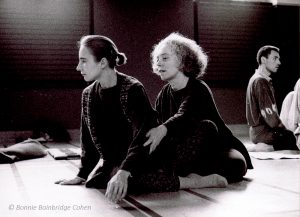
© Bonnie Bainbridge Cohen
The following is an excerpt from the Moving from Within chapter in Bonnie’s book, Sensing, Feeling, and Action, published by Contact Editions. This chapter is an interview with Bonnie and was first published in Naropa Magazine, Vol 1 #1, February, 1984.
Nancy Stark Smith: Where would you say your work began?
Bonnie Bainbridge Cohen: While I was in high school I was already exploring rhythm and dance with cerebral palsy children. I was then trained as an occupational therapist and worked in hospitals for ten years. Throughout this period, I was also teaching dance and working with dancers on alignment-movement problems.
During those years I had a lot of conflicts working traditionally in the hospitals. For example, as an occupational therapist I was only allowed to work with the upper extremities. I remember once I was working with a businessman who had been paralyzed on the left side of his body by a stroke. The prognosis of his left arm was very poor and I wasn’t supposed to work on it. But he was desperate for someone to help him with his arm. In general, his condition had left him feeling helpless and impotent as a man. I thought that until someone worked with his arm he wasn’t going to be satisfied and he deserved the chance. I decided to try. But my supervisor felt that I was encouraging him “falsely.” So I was already on tenuous ground. Then one day his wife came to visit. He was in a wheelchair, and he wanted to walk across the room. Instead of going toward the physical therapist who was standing nearby, or to his wife, he reached for me. I gave him my arm and we walked across the room. The PT was infuriated that I had usurped her job since I was only to work with his arms, one of which I was criticized for working with, and ambulation or gait training was not my job. So it was difficult to work with a person as whole being; they were only seen as parts. I felt stifled.
I was eventually dismissed from that hospital and I went to work at the Ohio State University Rehabilitation Center where they liked the work I did very much and encouraged me in my creative ideas. The rehab center sent me to Rancho Los Amigos Hospital in California for a three-month postgraduate program which was directed by Betty Yerxa. Under Betty’s tutelage I received an excellent training in physical rehabilitation. I learned how to see physical conditions, and how to clearly organize the details of what I saw. I learned through touch, all of the muscles of the upper extremity and how they compensate for each other when one is partially or fully paralyzed.
It was Dr. Ernest Johnson, the head of Physical Medicine and Rehabilitation at Ohio State University, who sent me on the path I’m on now. He said that people had a way of getting better when I worked with them, and that I needed to find out what in my work was me and what was technique.
Nancy Stark Smith: So would you say that you had some kind of natural or intuitive ability as a therapist?
Bonnie Bainbridge Cohen: Well, it seems I’m very good at seeing patterns, and how they relate to the whole picture. I have also, through the years, had excellent teachers. But long before I could describe what I was doing, I was able to see and to help people help themselves. There was a woman whose arm was shorter than the other from a birth injury. She couldn’t lift it. Within a month of working with her she was lifting her arm above her head, and it was the same length as the other. But then I couldn’t explain what I did. In some ways I’m not doing anything all that differently now from what I did twenty years ago. But now I’m better able to describe the principles.